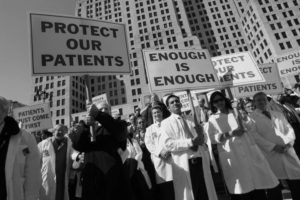
It’s no secret that the medical profession involves a complex series of training and exams before a doctor can enter the medical field. However, getting a physician license in the Big Apple tends to present a whole new set of challenges on its own.
The process requires you to pass multiple Medical Licensure Examinations, complete a residency program, collect certain certificates and meet other eligibility criteria before you can even apply. It goes without saying, there’s a hefty amount of paperwork involved too.
The following article covers the basics of what you generally need to know.
Regulation of MDs in the State
The New York State Board of Medicine governs the rules and regulations for licensing and practicing medicine in the region.
However, the Office of the Professions, a part of the New York State Education Department also plays an important role. In fact, it is the main body that maintains the records and licensing information, in addition to issuing the permit itself.
The application and fees for the license need to be submitted to the Office of the Professions.
General Requirements
According to the State’s Board of Medicine, anyone interested in working as a physician in New York must:
- Be aged 21 or above
- Have a good moral character
- Fulfill the academic, examination, and experience criteria (discussed in detail later)
- File an application along with the specified fee in full
Licensing Fee
Currently, the application fee for obtaining a physician license in New York is $735.
Note that this is separate from all the test registration fees which ought to be submitted at the time of appearing for the respective exam.
The licensing fee is subject to change, so make sure to check if it has been revised at the time you apply.
Applicants can pay the fees via money order or a personal check. Cash is not acceptable.
The check/ money order, along with the application form needs to be mailed to:
New York State Education Dept
Office of the Professions
P.O. Box 22063
Albany, NY 12201
If you are a foreign practitioner applying from outside the U.S., make sure that you make the payment on a U.S. bank and in U.S. currency.
Education and Experience Requirements
Based on the education and experience required, the eligibility criteria for becoming a licensed physician in New York can be divided into four main parts:
- Get an ECFMG certificate (for foreign candidates only)
- Register with FCVS
- Complete a residency program
- Pass USMLE Step 3 Exam
Completing each of these steps is a long and hard journey and can constitute a lengthy guide of its own. Here, we have highlighted the major aspects of each article that can provide you with a good idea of what’s involved.
Get an ECFMG Certificate
If you have received your degree from a medical school located outside the U.S., you will need an ECFMG certificate.
The Educational Commission for Foreign Medical Graduates (ECFMG) is a governing body that helps international candidates find and pursue a career in medicine in the U.S.
In order to get certified by the ECFMG, you will need to submit an identification form along with your final medical school transcript.
You can submit your documents in hardcopy although they have an online portal to make things more convenient.
You will also need to pass the United States Medical Licensing Examination (USMLE) Step 1 and Step 2 exams. The total fees for each of these exams is $790. The Step 2 exam has a second module that costs an additional $1,375.
Register with FCVS
The Federation Credentials Verification Service (FCVS) provides a standard for the relevant authorities in all states to view and verify the medical credentials of any physician practicing in the country.
You can register online or send your application by mail. The documents required for this step include photocopies of your:
- Medical degree
- Clinical clerkship
- Training certificate
- ECFMG certificate
- Proof of identification
The charges for this step range upwards of $325.
Complete a Residency Program
Once you have created a profile at FCVS, you need to find a residency program, sometimes also called a fellowship program. These medical training programs must be endorsed by the Accrediting Council on Graduate Medical Education.
Generally, residency programs take 3 to 7 years to complete. But in some cases, you can apply for the next step while still serving as a resident.
Pass USMLE Step 3
The last requirement for receiving a physician license in New York is to clear the USMLE Step 3 exam.
To save time, you can fill out the application form before appearing for this module. However, the license will not be issued until you have submitted proof of passing this exam.
According to the USMLE board, it’s best to take Step 3 after competing (or when you are close to completing) the first year of your postgraduate training in a U.S.-accredited medical education program.
End Note
We hope this gives you a general idea of what’s involved regarding acquiring a physician’s license. We suggest you follow up with researching the processes and exams mentioned. If we were to provide all the information here, it would probably extend to over 100 web pages.
With that said, here is a general summary. There is a required completion of a residency program of a minimum of three years (in any state) as well as passing Step 1 to 3 of the USMLE test. Your eligibility for becoming a licensed physician is also subject to various additions certifications but all in all, it is well worth it. According to the data collected by Indeed, physicians in New York have an average annual income of at least $230,000 – which is a whopping 15% above the national average!

